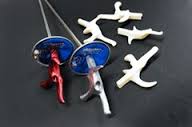I’ve given (shorter and less detailed) variants of this argument many times. I agree with pretty much everything he says here:
I started to learn sport fencing (or “Olympic-style”) as a child in England. My parents were both long-time fencers, so one of my earliest memories is from around age three or four, standing in our tiny backyard, trying to learn basic parries with a foil. My father had been experimenting with bringing in a form of rapier and dagger at his fencing club, but there were no reasonable simulation rapiers on the market in those days, so the default equipment was a sabre and a broken-off foil as a dagger. Let’s just say that the idea was very popular in the club, but the implementation failed to energize many because the equipment wasn’t all that close to representative: the weapons were far too light and any attempt to use historical methods was doomed because the swordplay lacked the momentum of full-sized/full-weight rapiers. Things that worked fantastically well with the modern weapons would get you deader than dead using proper historical weaponry.
 I gave up sport fencing as a hobby around the time that orthopedic grips and electrical scoring came in … as the man says in the video above, it became too much like electric tag and too little like historical swordplay. Instead of being relatively straight or slightly curved, orthopedic grips looked rather like what would happen if you squeezed a ball of soft coloured clay in your hand. I hated the feel of them, but other fencers at my club loved them. The electrical scoring system of the day required each fencer to wear an over-jacket covering the valid target area, and trail along a cable attached to the back of the over-jacket. The matching foil had a socket on the inside of the guard for attaching the cable to the other side of the scoring circuit. When the tip of the foil hit the conductive surface of the opponent’s over-jacket, the circuit was completed and a point would be scored.
I gave up sport fencing as a hobby around the time that orthopedic grips and electrical scoring came in … as the man says in the video above, it became too much like electric tag and too little like historical swordplay. Instead of being relatively straight or slightly curved, orthopedic grips looked rather like what would happen if you squeezed a ball of soft coloured clay in your hand. I hated the feel of them, but other fencers at my club loved them. The electrical scoring system of the day required each fencer to wear an over-jacket covering the valid target area, and trail along a cable attached to the back of the over-jacket. The matching foil had a socket on the inside of the guard for attaching the cable to the other side of the scoring circuit. When the tip of the foil hit the conductive surface of the opponent’s over-jacket, the circuit was completed and a point would be scored.
It was clumsy and awkward, and didn’t feel much like a swordfight. I pretty much gave up the foil and switched to sabre, for they didn’t yet have a working electric system for sabre fighting, so you didn’t need to get hooked up to the machine just to fight a bout. When they got that little problem fixed, I’d already given up sport fencing.
The SCA finally adopted rapier fencing and the Historical European Martial Arts (HEMA) movement arrived well after I’d given up sport fencing, and I’ve enjoyed the SCA’s rapier combat quite a bit (although I tend to go inactive for a year or two, then go back for a similar length of time … I may not improve that way, but it’s still fun). More serious fencers and those interested in a wider range of styles end up joining HEMA organizations, where I’m told they take things much more seriously. I can’t say from personal experience, as I only visited a Toronto HEMA group once and most of the members there were working on much earlier styles of swordplay (like longsword) than I was interested in at the time.
H/T to Brendan McKenna for the link to the video.



